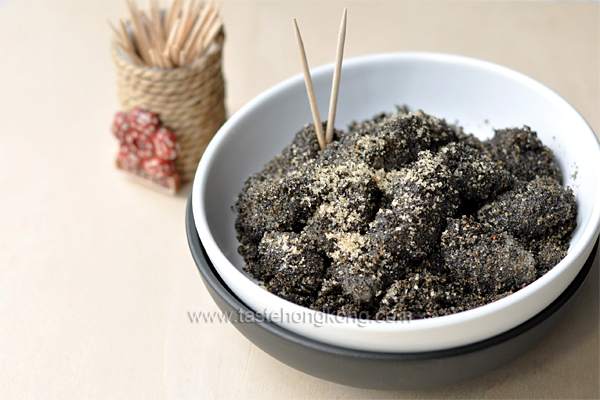
Do you recognize it – a once-popular-roadside-food in Hong Kong?
Not yet?
Does it make any sense if I tell you we call it Loh Mei Chee 糯米糍 in my place? Or, Chee Ba 糍耙 or Muah Chee 麻糬 in other regions in China?
Stiil no?
No worries, it is not your problem. The traditional Chinese mochi is supposed to look brownish yellow than black.
I twisted the recipe, replacing the ground white sesame seeds by black.
White or black sesame seeds, they both are considered as healthy foods, which are amongst the seeds rich in vitamins B and minerals like calcium, magnesium, iron, etc. The black type, also the less processed, however has a stronger aroma and is said to contain a higher content of antioxidant.
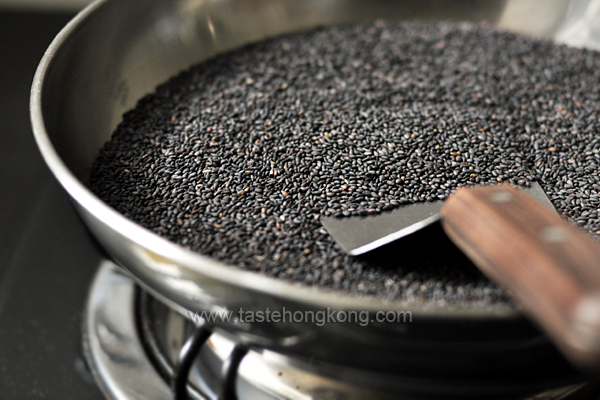
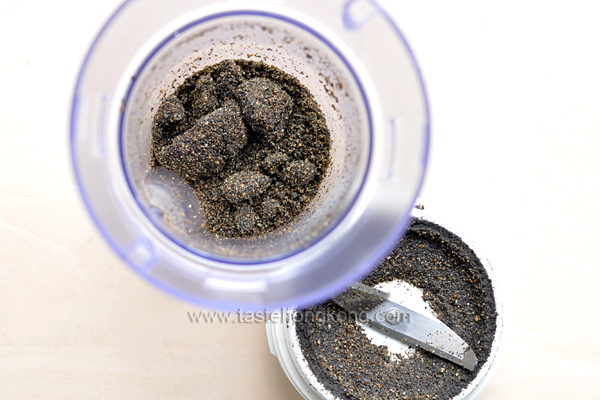
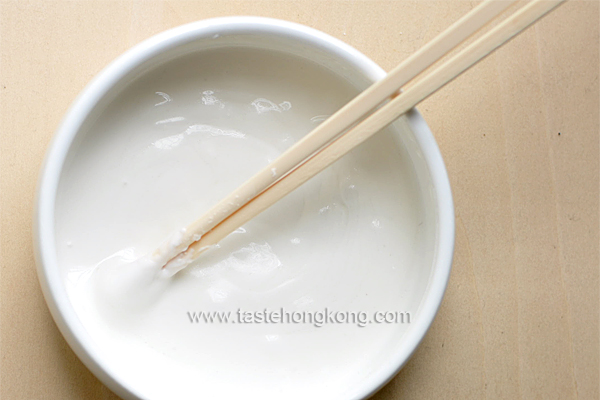
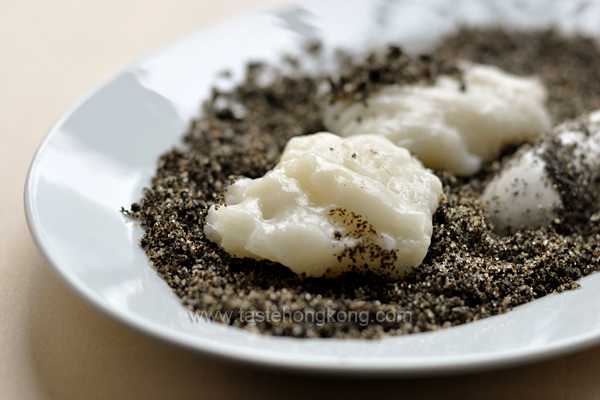
Sesame seeds tastes better when toasted. I made this with a ‘white wok’, the same traditional way as I toasted the dried shrimp roe.
Toasting sesame, black sesame seeds in particular, takes time and requires good attention. How could we tell a black thing is browned but not burnt? No fear, I’ll tell you my tricks in the steps below.
There will be a strong odor from the black sesame seeds as soon as they are being ground. To me, this fresh and pleasant odors already justify all the efforts. Although pre-ground black sesame powder are available in many supermarkets or grocery stores, I can’t recommend grinding your own enough.
- Ingredients
- 100g sticky (glutinous) rice flour
- 110ml water
- 2 tsp cooking oil (I used canola oil)
- 6-8 tbsp sesame powder
- 3-4 tbsp brown sugar, or to taste
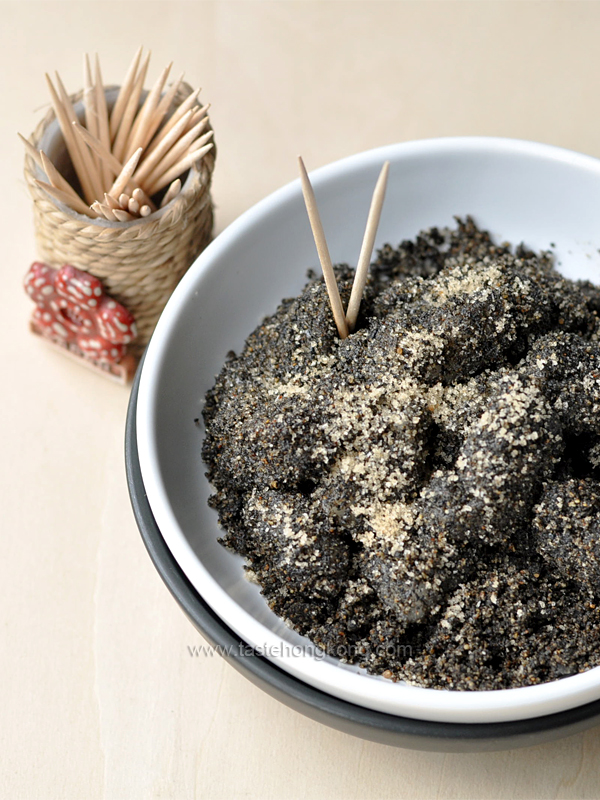
Method
Sesame seeds
Spread out the sesame seeds on a flat plate and pick through to remove any debris, or small stones.
Wash black sesame seeds thoroughly in a fine colander under running water. Or, nest the colander in a large bowl, and wash seeds thoroughly in several changes of water.
Drain dry sesame seeds. For a larger quantity, I’ll rest them overnight (wet sesame seeds will requires longer toasting time).
Heat a pan over low to medium flame, without any oil (this what we called ‘white wok’), put in sesame seeds. Keep stirring them by a turner.
In 10 to 15 minutes or so, depending on the amount you are working with and how wet the sesame seeds are, you shall start hearing a slight sound of ‘lik lik lak’. Lower heat and cook for another minute to make sure all are cooked through. A trick to eliminate the guesswork: mix in at the very beginning a small portion of white sesame seeds, which shall give you a better visual clue as when they are browned (lightly browned would be enough).
Let cool sesame seeds, briefly pulse them in a grinder to form a coarse powder (fluff them if they lumped together). If you are handling a small batch, say a few table spoons, you may simply grind them by a rolling pin.
Mochi dough
Mix well sticky rice flour, water and oil in a bowl. Steam it over medium heat for about 15 to 20 minutes, or until the dough cooked through.
Putting together
Mix sugar with coarsely ground black sesame powder and spread them flat on a plate. Scoop out the cooked (gooey) dough and lay it on the bed of sesame powder. Flip the dough to coat it evenly with the mixture.
Coating the cooked dough reduce its surface stickiness. Then use a light greased scissor to cut the dough into portions and coat each of them (the mochi) with enough sugary sesame powder.
I find it best to serve the mochi warm, enjoy!
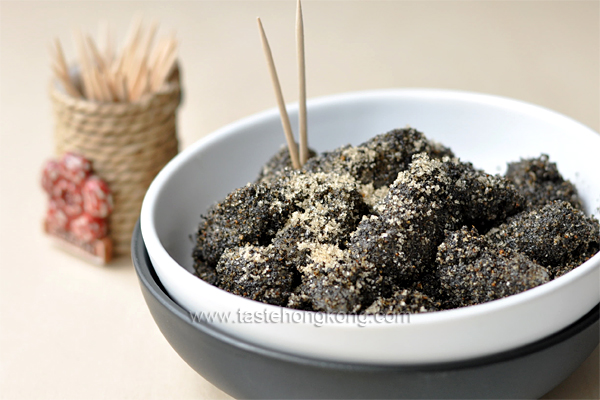
Note:
The coating for classic Loh Mei Chee contains not only ground white sesame seeds and sugar but also ground peanuts. But you may consider other ground nuts for variations, like cashew nuts.
As you might aware, I have toasted quite a large batch of black sesame seeds. They are not only used for making these mochi but also, with the added of oil and sugar, sesame butter and tong yuen (as fillings). But I will only grind them on the day I use them and now they are being stored in an air-tight container.
- Category: Rice and Grain .
- 25 comments
To get immediate updates and new recipes from my blog, you may also SUBSCRIBE them via RSS feeds. See you there.
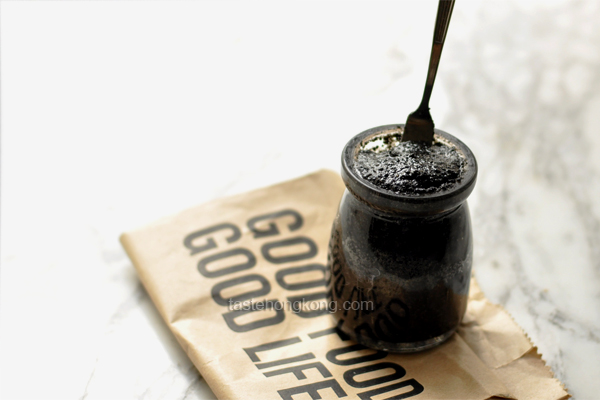
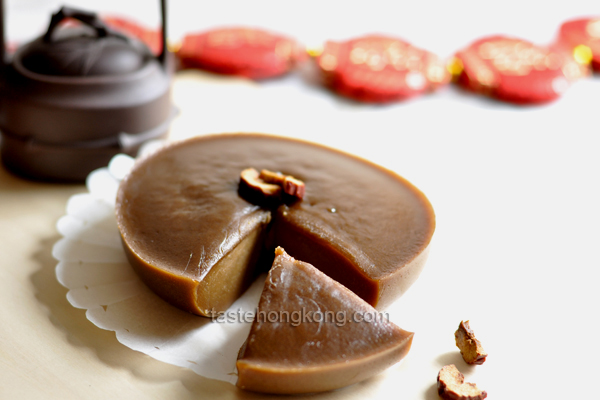
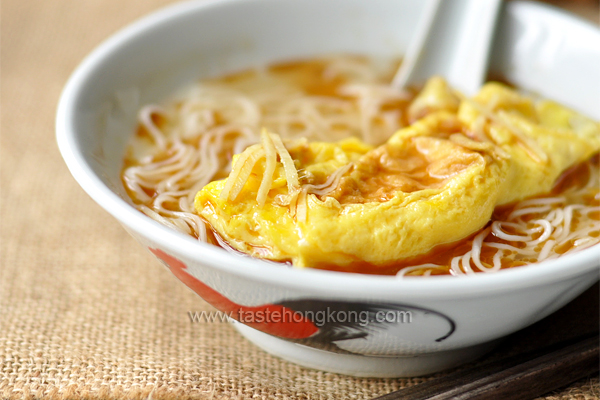
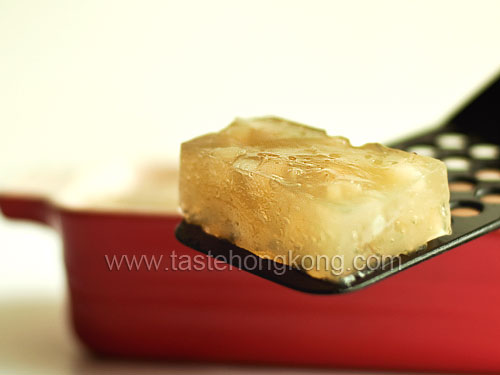
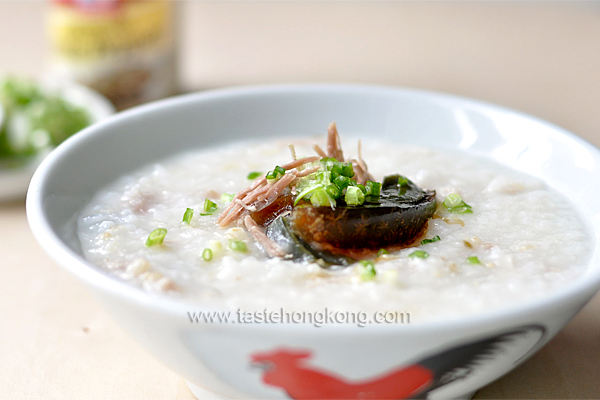
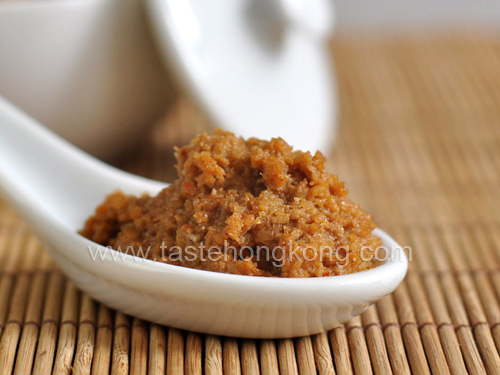
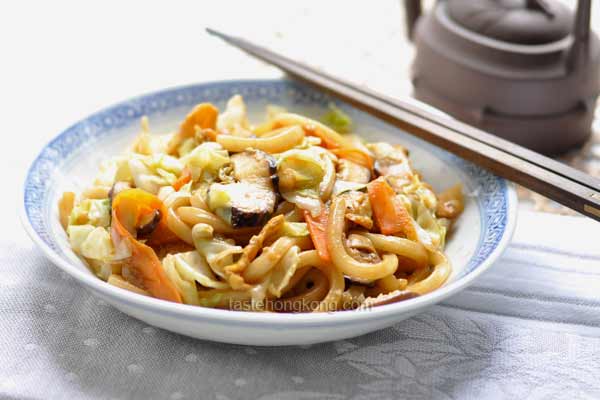
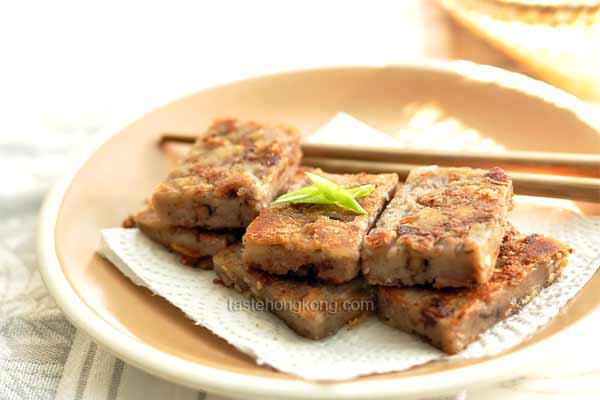
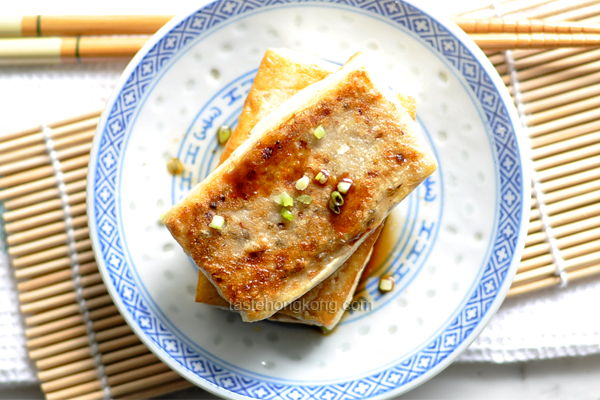
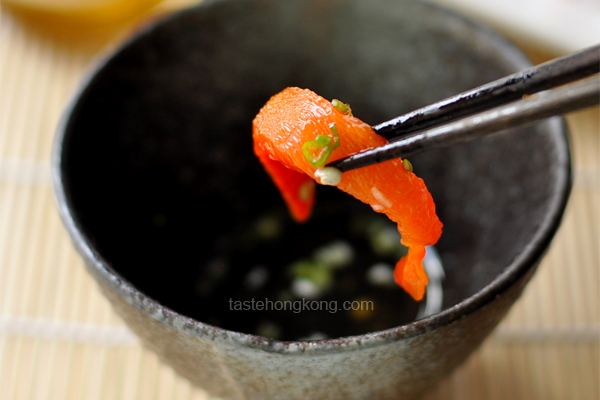
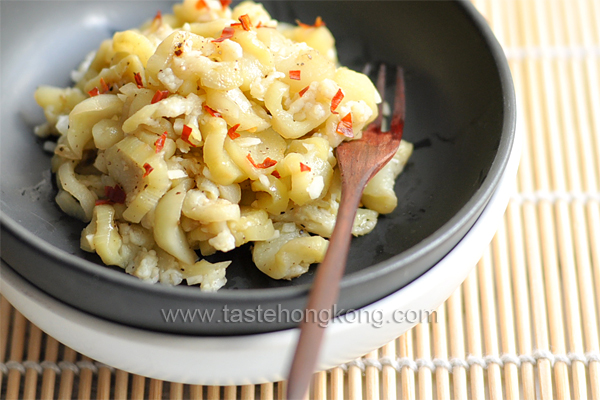



I think the black type looks even more photogenic than the usual brown muah chee 🙂
I love mochi with sesame seed, but I usually have in a reverse way, where the sesames are inside the mochi dough 😉
Looks delicious, I am a mochi fan.
Hope you are having a wonderful week!
I ve learned some few new things in your post. very interessting read!
I didnt know black sesame seeds had more B3 and antioxidants. god to know though!
Do u buy your sticky rice floure ready made or do u make it by mixing powder with liquid?
Hmmmm lor mai chee – anything glutinous makes me happy. Thanks for sharing, you ALWAYS manage to bring me back so many happy memories of HK 🙂
@Helene Dsouza I Masala Herb,
Glad that you find this interesting. I mixed sticky rice flour with water and oil right before steaming.
@Lucy L,
You are welcome!
I haven’t see this on street for ages : (, but it shall not disappear in my kitchen : ).
I love the idea of using black sesame seeds for coating. Haven’t eaten mochi for a long time. This recipe is definitely a keeper for me. 😉
I love muah chee and I always seen this in the market. Thanks for sharing the recipe, definitely want to try this out.
Plus, black sesame seeds are particularly good for women! Hee hee! Double bonus to have such sweet treats 🙂
This looks really interesting! I love mochi and the use of black sesame seeds just looks yummy!
Wow!!! I used to eat this at my grandmom’s place on the first day of Chinese New Year! I can’t wait to make this! Thank you very much for sharing.
These bite-sized mochi look awesome! Healthy and delicious. What more could one ask for!
Oh oh oh! I remember eating these as a kid~ But they’ve kinda disappeared on the streets now 🙁 So glad you shared this recipe 🙂
maureen, i can imagine how aromatic these loh mai chee is! you’re an inspiration!!
Hi! i would like to ask what ‘s the purpose of the oil to be added into the mochi? Is the oil added in all kind of mochi?
@Connie,
I believe it has to trace back to the old fashioned way of making this, where lard was used for added flavor and silkiness. But most likely, this does not applies to all; Japanese mochi is one probably doesn’t comes with oil.
Hi ! I love these treats and crave for trying out your twisted recipe… But do you know if there a way to reheat the mochis (because it’s neither easy to make just a small amount of them nor to eat alone two servings at once : sadly my fiancé is very skeptical about chinese cuisine…) ?
@Helena,
I know some would moist the leftover steamed dough a bit, covering with film, and reheat it (without coating of the sesame seeds) in a microwave oven. But honestly, I don’t really enjoy eating mochi which has been reheated.
[…] Read Rate this:Share this:Like this:LikeBe the first to like this. This entry was posted in Cook, […]
Hi! I made this recently, and it was a little messy. The glutinuous rice dough stuck to the metal plate I steamed it in. It was really hard to scoop it out and onto the sesame, and pretty much impossible to flip the dough. Do you oil the container first before steaming?
Thanks so much for posting all these authentic recipes! I’ve made about 6 of your recipes, and everything is delicious, easy, and feels like home.
@Ana C.
I didn’t oil the container, which is a ceramic bowl, cause the dough already contained oil. It might be a bit sticky to turn out the dough but should not be impossible. Just wonder if the batter was spread thin on the metal plate thus increasing the sticking area (and not sure if the metal plate may accelerate the lost of moisture when heated — the dough should come out moist as pictured). Of course, you may try oiling your container.
Hope this helps.
@Ana C.
By the way, the water in gram shall be ~110 grams. Flours may behave differently, so the figures are just for reference. With the right consistency, the batter should be able to level itself in the bowl with a smooth surface. And it is better to turn out the steamed dough while it is still warm.
I enjoyed this today again but with ground roasted peanuts and raw sugar.
Have fun and enjoy yours!
[…] Source: Read […]
Sounds delicious but I didn’t quite get the sesame seeds toasted till fragrant. Will try again. Thank you for sharing.
@Christine,
Thank you for your interests in trying out this recipe. Hope my delayed reply has not put you off making this.
It means you shall smell the nutty flavor of sesame seeds when the sesame seeds are toasted enough (here I do it in a pan over heat). But once they are toasted enough, be careful they can also be over-cooked easily by the residual heat in the pan, thus causing a bitter taste. If you are unsure, transfer the toasted seeds to a dish to let cool.
Enjoy!